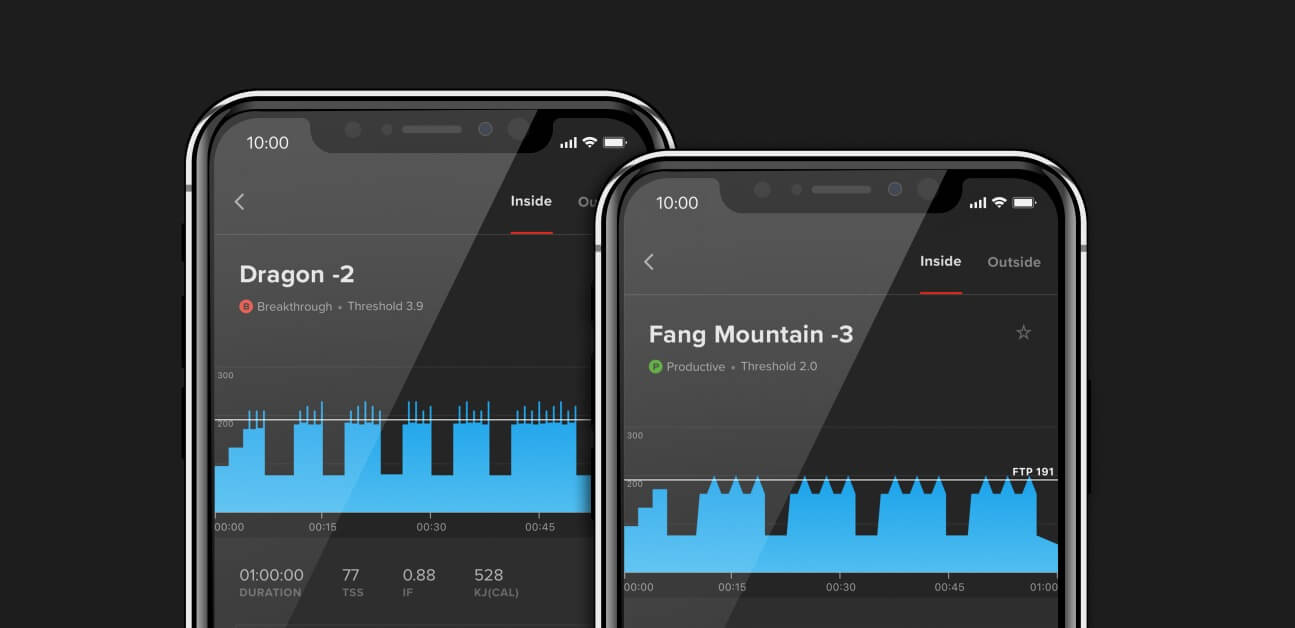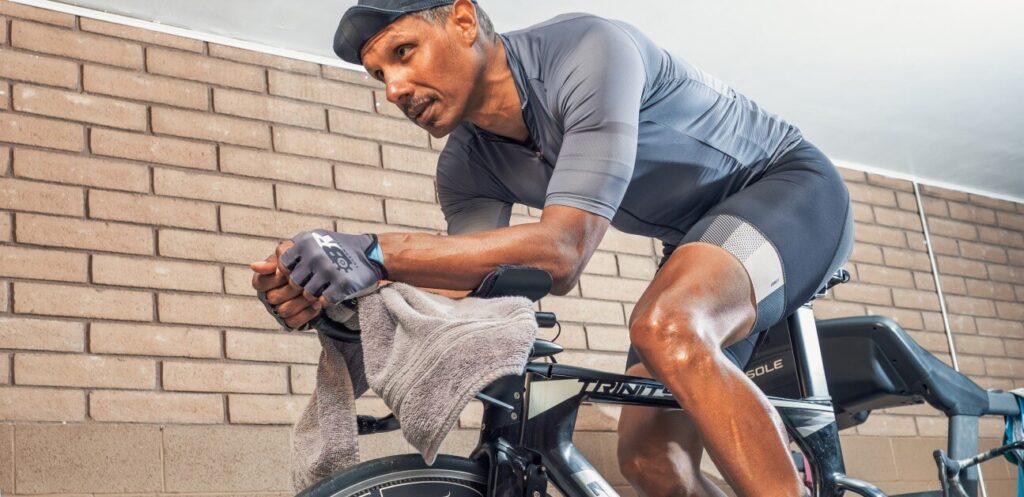Over-Under Intervals & Workouts: The Science Behind Them and Tips for Success

Over-under intervals improve your ability to shuttle and buffer lactate near the boundaries of your threshold power. Improving these capabilities will increase your anaerobic capabilities allowing you to output higher power values with greater efficiency and less mental fatigue.
What are Over-Unders?
If you’ve followed a TrainerRoad training plan before, you’re probably no stranger to over-unders. Over-unders are a type of interval structure with sustained intervals divided into segments that alternate between under-segments, resembling valleys, and over-segments resembling peaks. While over-under intervals are typically reserved for threshold workouts they can be found in a handful of sweet spot and VO2 Max workouts as well.

In an over-under set, the valleys target the low end of a set range while the peaks target the high point of that set range. Depending on the goals of the workout and the relative difficulty of the Workout Level, the intervals might be longer in duration but lower in intensity, or shorter in duration with larger jumps between the valleys and peaks. Pierce -4 is a good example of a workout with shorter intervals and a large discrepancy between valleys and peaks.
The Science Behind Over-Unders
The primary objective of over-unders is to increase your ability to tolerate and utilize the byproducts that accompany riding above your FTP, or close to it. Over-unders achieve this with improvements to lactate shuttling and lactate buffering abilities—essentially targeting how well your body handles the accumulation of lactate.
Lactate is a substance produced by the muscles during anaerobic activity, through a process known as anaerobic glycolysis. In summary, lactate is produced when we process glucose anaerobically through the anaerobic glycolysis chain. One of the outputs of this process is pyruvate. Pyruvate is an essential substance responsible for fueling aerobic metabolism. When pyruvate begins to accumulate at a higher rate than we can utilize, the result is lactate. While lactate has traditionally been thought of as a waste product recent research suggests that the body can actually use it as a secondary fuel in the muscles, heart, brain, liver, and kidneys. Where lactate becomes an issue for athletes is when it accumulates beyond a point of utilization, leading to a rapid decline in performance.
At a certain point, the system either can’t clear or utilize the lactate at the same rate that it’s being produced. While it remains unclear exactly why this performance limitation occurs, It probably involves the inability to fully utilize the lactate itself, as well as muscular acidosis caused by metabolic production of hydrogen atoms. Regardless of the exact cause, when lactate production overcomes utilization, lactate makes its way into the bloodstream, and blood and muscle pH lower. This drop in pH is what leads athletes to experience a rapid decline in performance. Over-under intervals are specifically designed to increase your system’s ability to handle the accumulation of lactate.
More on Lactate and Lactate Threshold
The over-segments or ‘surges’ in over-under intervals flood the muscle with these metabolic byproducts. When you reach the valleys, you’ll have a small opportunity to back off and recover, while your muscles process the lactate. By repeatedly flooding and clearing your muscles with lactate, over-under intervals encourage quicker and more efficient lactate management. This improvement helps forestall the point at which lactate causes lower blood and muscle pH thus increasing your ability to target higher sustained power outputs for longer durations. As a bonus, these intervals also allow you to accrue more work without the same level of fatigue you’d incur riding at the peak values, continuously without small bits of ‘recovery’ in between.
The over-under structure has a way of pushing up against mental limits repeatedly as well. When you finish a segment at a higher intensity it’s not uncommon to feel like you won’t be able to maintain that level of intensity for that duration again. Oftentimes, the valley gives just enough recovery that when you reach the next peak, you’re able to push through another interval you thought you couldn’t. This repetition helps build mental resilience and fortitude.
Example Over-Under Workouts
These are a few of the over-under workouts you can find in the TrainerRoad workout library and TrainerRoad training plans. As you’ll notice these workouts can target different power zones and energy systems but follow the same interval structure, with high peaks and low valleys.

Icefall -3 includes four twelve-minute Sweet Spot intervals with two-minute valleys at 80% FTP and two-minute peaks that alternate between 95% of FTP and 100% of FTP. These intervals dial things down towards the sweet spot and tempo power ranges to make the work more tolerable while remaining productive.

Bear Creek is an over-under workout that targets the threshold power zone. It includes three twelve-minute intervals with over-under intervals alternating between 2 minutes at 95% FTP and 2 minutes at 105% FTP. These intervals help increase how long you can work above FTP and how quickly you can reprocess the lactate buildup that leads to muscle acidity. Equally as important, the short efforts above your current FTP can help increase FTP.

Ritter is an over-under workout with a bit of variation. This workout includes sets between five and nine minutes, with intervals alternating between peaks of 45 seconds at 95-97% FTP and peaks of 15 seconds between 110-120% FTP. The valleys in these workouts are already so close to FTP, that it only takes a slight increase in effort to flood the muscles.
Looking for over-under workouts? You can find over-under workouts in the TrainerRoad workout library online or in the TrainerRoad app. Just type over-under into the search bar of the workouts tab and use filters to refine for zones or Workout Levels.
Tips for Successful Over-Under Workouts
If you’ve done a few over-under workouts before, you’re probably familiar with how challenging they can be. Like any challenging workout though, there are a handful of things you can do to increase the likelihood of a successful workout while decreasing the rate of perceived exertion.
Fuel Your Over-Unders
Sweet spot, threshold, and VO2 max intervals are highly glycolytic efforts that shift fuel demands from fat to sugar. Fueling before, during, and after with carbohydrates ensures that you have enough fuel on board to power through all of your threshold efforts. Going in fueled can also decrease the rate of perceived exertion. To ensure that you have this advantage, eat a carb-rich meal two to three hours before your workout. During the ride, plan on taking in 60-120g of carbs per hour to stay on top of your system’s demand for fuel.
Adaptive Training
Get the right workout, every time with training that adapts to you.
Check Out TrainerRoadListen to Music
The more physically challenging a workout is, the more cognitively demanding it is too. As a result, you may find that the TV shows, movies, or podcasts that made your rides more enjoyable during low-intensity workouts are suddenly making your workouts feel harder during higher intensity workouts. On the opposite end of the spectrum, music can actually have positive effects on performance and help reduce RPE during high-intensity training. Instead of listening to something that demands your focus, we recommend listening to music with a higher tempo and a more upbeat rhythm. Try also watching something on another screen that you don’t have to pay much attention to but can offer a visual distraction when you need it most.
Ride With a Fan
If you’re doing an over-under workout indoors, you’ll want to ride with a fan. Riding indoors provides significantly less airflow than riding outdoors, which negatively affects your body’s ability to cool itself. The impact grows considerably more challenging as you progress into more intense intervals. Riding with a fan during these intervals can help reduce the RPE of your workout and increase your efficiency indoors.

